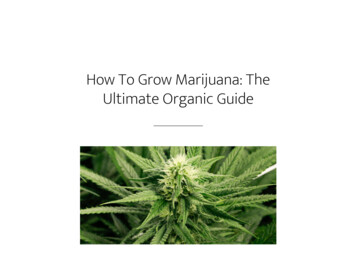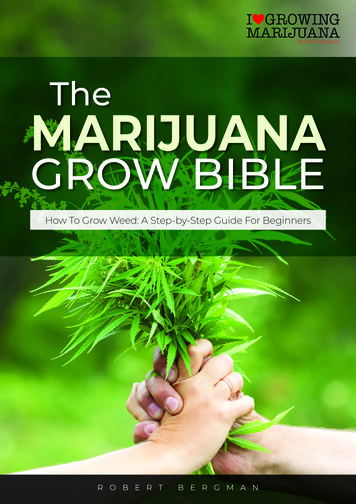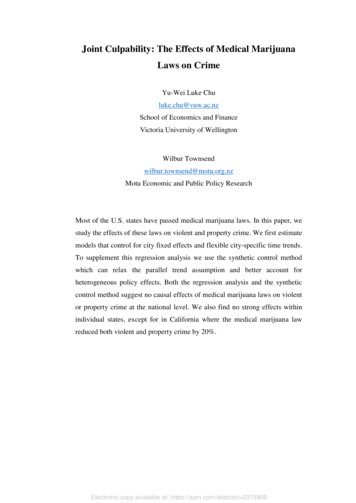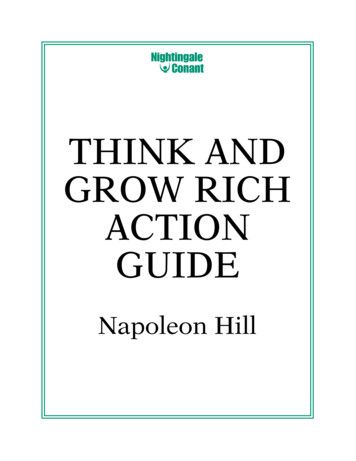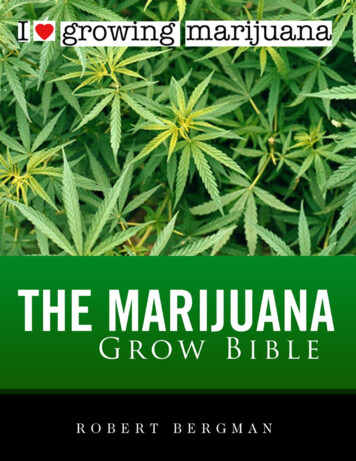
Transcription
Marijuana Grow Guide for BeginnersCongratulations! You’ve just downloaded the Marijuana Grow Guide For Beginners. This grow guidewill learn you everything you need to know about growing marijuana. Every aspect of the completegrowing process is explained. From germinating seeds to drying and storing your marijuana buds,both indoors and outdoors. Carefully read this eBook and start growing like a professional.I wrote this eBook after receiving many questions and requests from website visitors atilovegrowingmarijuana.com. Many people requested an collection of the articles on my website aspdf to read on an Ereader or Ipad. I want to help people grow and I hope you share your knowledgeas well. Feel free to share this document with fellow growers. Please read our disclaimer, NO RIGHTSRESERVED!This Ebook contains material not protected under International and Federal CopyrightLaws and Treaties. Any unauthorized reprint or use of this material is allowed. Any partof this book may be reproduced or transmitted in any form or by any means, electronicor mechanical, including photocopying, recording, or by any information storage andretrieval system without express written permission from the author / publisher. Pleaseshare this book with your friends and companion growers.So if you want to grow medical marijuana, marijuana for recreational use or make some money withit, this beginner grow guide will help you grow the best marijuana. Learn all about marijuana seeds,watering, pruning and harvesting marijuana both indoors and outdoors. If you grow marijuana indoorsyou can yield up to 18 ounces per 10 ft2 with a 600 watt HPS light. Outdoor yields of up to 18 ouncesper plant are possible. It all depends on the love and care you put into growing marijuana.For any additional information, questions, suggestions or proposals, please visit www.ilovegrowingmarijuana.com or contact me directly on robert.bergman@ilovegrowingmarijuana.com. For daily updates and the latest growing techniques add me on facebook or google .Happy growing,Robert Bergman
I GROWINGMARIJUANAContentsChapter 1 - Before you startChapter 3 - Outdoor marijuana growingPrefaceTypes of marijuanaMarijuana seedsWhere to growOutdoor growingSoilSowing the ngPests and problemsCompanion plantingNatural predatorsRepellent methodsSecurityChapter 2 - Indoor marijuana growingIndoor growingLightsGerminationGermination SoilSeedlingsWatering seedlingsTransplanting seedlingsVegetative growthWater and lightingSoil controlNutrients and feedingPruningEnvironmental factorsDetermining sexForced floweringPest and problemsSecurityChapter 4 - HarvestingThe harvestPreparationDryingStorage
PrefaceMarijuana is likely one of the most interesting and rewarding plants to grow if only because it has aremarkably short lifespan. You get to see the entire process from germination to harvest in only threeto six months, and, of course, you get to enjoy the fruits of your labor when the process is finished.Many prospective growers might take to growing marijuana with an air of nonchalance, but that isreally not the way to go about it. It is a labor-intensive effort that requires you to take great care ofthe plants if you want the best product by harvest time. Even though it can be somewhat difficult,that doesn’t mean it shouldn’t be attempted at all. In fact, many people who have no gardening orhorticultural history whatsoever have taken to growing cannabis. Many people suggest that, while youcan’t become addicted to marijuana use, you can certainly become addicted to marijuana growing.This beginner grow guide can certainly give you solid foundation to help make growing your marijuanagarden a much simpler process overall.Of course, as marijuana’s murky legal history in the United States (and, really, around the world) willlet you know, growing marijuana comes with a certain amount of risk. Even states that have legalizedmarijuana use recreationally (Colorado and Washington) still maintain strict laws about actual marijuanagrowth. Indeed, the federal government has yet to back down from its stance that both marijuanapossession and growth are punishable offenses. But that doesn’t stop people from growing it andthere are plenty of ways to ensure that you maintain a certain amount of security during the process.The interesting thing about marijuana’s legal status in modern times is that the plant and humanityhave shared a sort of symbiotic relationship for centuries. The plant has thrived as a result of cultivationand humans have benefitted from the medicinal effects that cannabis provides. Indeed, up until about70 years ago, cannabis was used in Western medicine as a way to treat all kinds of different ailments.Unfortunately many governments across the world have criminalized it despite the fact that it is one ofthe most innocuous drugs you can use. It does not have the addictive properties of hard narcotics likecocaine or heroin, and, in some cases, it’s even safer than using commonly prescribed drugs. So growand smoke as you want
Types of MarijuanaMarijuana is one of the only annual plants to have two different sexes. This means that plants can comein both male and female varieties, and even occasionally hermaphroditic varieties in which the plantfeatures both male and female reproductive organs. There are also three major species of marijuana: Indica: Relatively short and wide, with greener colors and round leaves that have marble-likepatterns. Provides a heavy, body high. Sativa: Can grow taller, but are thinner with more pointed leaves that don’t have patterns onthem. Provides an energetic, cerebral high Ruderalis: Lesser known among the other two. Small plants, used primarily for making clothes,ropes, etc.Each of these types of marijuana has its own properties when it comes to actually using it. One of thelargest indicators of potency for a particular plant is its THC (tetrahydrocannabinol) content. This isessentially the stuff that provides the soothing, medicinal qualities that many people associate withcannabis. In general, most growers use indica, sativa, or hybrid varieties of the two. Ruderalis generallygets left out of any cannabis cultivation because it lacks a high amount of THC. In addition, it shouldbe pointed out that the female sex on the cannabis plant is most-prized by growers because of its highTHC content.Indica, small and bushySativa, tall and thinRuderalis, hemp. Low THC
In large part, the THC in female plants rises when the plant remains unpollinated. It will producemore flowers, more buds, and more THC resin, making the eventual smoke much more potent bythe harvest. There are also plenty of other natural chemicals on a marijuana plant that influence thekind of high you receive. These chemicals are referred to as cannabinoids and they interact with yourcognitive and physical functions to produce altered states of mind and being. Growing the plantsunder ideal conditions will promote high-quality THC production in your female plants. Indica/Sativacrossbreeding’s like Skunk, Northern Lights, Orange Bud and Blueberry are very popular. Read moreabout different marijuana strains
Marijuana SeedsThere are a number of ways to find marijuana seeds, but if you’re in the United States, almost all of themare illegal. Of course, the most effective (and least costly) way to get seeds is by receiving them from afriend. First of all, you’ll stay off the radar of any law enforcement, and the seeds will be coming from atrusted source. There will be no surprises when it comes to the growth period or harvest time. Gettingseeds from a fellow grower is the best of every world but sometimes you won’t have that option.Another option you have at your disposal is buying seeds from a dealer. Of course, you’ll need tohave some inroads into the black market and this option is really a toss-up when it comes to quality.It’s possible to finish with some weird, but very nice plants, but some of the seeds might be inert andwon’t grow adequately or at all.Your third option is to go to a seed bank. You can find a lot of these online, most of which are based outof the Netherlands or Canada where it’s legal to sell marijuana seeds. Unfortunately, many Dutch seedbanks refuse to ship to the US, and there is a decent possibility of getting ripped off in the end. There’svery little risk of being caught by any authorities because the seeds are packaged discreetly. Of course,if a postal employee mishandles the package, the seeds might come to you cracked or otherwiseunusable. If you live near the border with Canada, you can cross the border and find a physical seedbank that might be willing to sell to you.Healthy marijuana seeds
For novice growers who have some experience with different marijuana strains, locating a favoritetype is likely a priority. Most vendors categorize their seeds by strain. They might have special namesfor their individual strains, but the species (i.e. indica, sativa, etc.) will reveal what you can expect fromthe smoke. In any event, it’s important to find the seeds that best correlate to the smoking experienceyou desire.After receiving your marijuana seeds, make sure to inspect them for quality. Most mature seeds willhave a dark brown color with swirling or marbling patterns. Mature seeds like these are the ones mostlikely to germinate and thrive. Seeds that are a sort of pale green are often not mature enough andwere taken off the plant too early. There’s no harm in trying to grow these, but you might not have asmuch success. Once you have a fully-grown crop, you can harvest your own marijuana seeds and notneed to deal with anyone in the future. What are your favorite marijuana seeds? Leave a comment onmy article about quality marijuana seeds.
Growing MarijuanaObviously, obtaining seeds is only the first in a long line of steps that you must complete in order tostart growing your marijuana plants. Before you start doing anything, you need to know where thegrowing will ultimately take place. Of course, there are two major options: indoors and outdoors.Growing marijuana isn’t like picking up packages of pumpkin seeds at the grocery store and thenthrowing them into the ground. Many marijuana growers need to take stock of the feasibility ofgrowing marijuana in the space they have afforded to them. For example, do you have the space inyour house to grow marijuana indoors? How many plants do you want to grow? Are you prepared forall the vagaries of being a grower? If you’re growing marijuana outdoors, do you have a concealedlocation? How’s the weather where you live? How’s the soil?The following sections of this e-book will explore those questions and much more.Indoor GrowingFor many people, growing marijuana indoors is the only option. Luckily, cannabis is a relatively versatileplant and many varieties can be grown both indoors and out. Even so, you should check with thebreeder (if at all possible) to see where they meant for their plants to be grown. Sometimes breedersdevelop the seeds specifically for outdoor use. The last thing you want to do is grow marijuana plantsindoors that were really meant for the great outdoors.If you grow your marijuana plants under the right circumstances you can yield a lot of marijuana, overa pound per square meter. Temperature, air circulation, humidity and plant care have to be perfect butcan be controlled very well when growing indoors. No weather extremes or neighbor’s cat that willdamage your marijuana.
LightsLights often represent the lifeblood of plants grown indoors. Because any sunlight that they mightreceive is sparse, artificial light is valuable and necessary. Plants need the light to perform photosynthesis,which is vital for sugar and tissue production.Many people who grow for personal use will use a closet space for their garden. Some can get away withusing a guest bedroom that can’t be seen from the outside and is rarely used otherwise. Regardless,any grower must assess the viability, both in terms of space and electrical capacity, of bringing in alarge amount of lights.Most growers limit their choices to one of the following three: fluorescents, incandescents, and HID(high-intensity discharge) lamps. To save yourself some time and money, it’s in your best interest tojust opt for HID lamps during vegetative and flowering stage. These are sold as Metal Halide (MH) orHigh Pressure Sodium (HPS) lamps and they are, without question, the best for your marijuana garden.Although they have a higher up-front cost than fluorescent or incandescent lights, their overall value ismuch greater in the long run. That’s because they don’t require as much electricity as the other options,they are brighter, and they also last much longer. Even if you’re on a budget and you don’t want tothrow away money up-front, you must factor in the cost of the electricity bill and bulb replacements.Fluorescent lightMarijuana needs a lot of lightHPS light
So, when it comes down to it, MH and HPS lamps represent a much better value and a better productoverall. The plants will also need an even distribution of light so that growth is congruent. It is possibleto hook up a track system that allows the light(s) to be moved, a lot of professional growers use thistechnique. The plants will receive an optimal amount of light without the need for extra lights hereand there.For seedlings a HPS light bulb can be too much so many growers use fluorescent lights duringgermination. They don’t produce a lot of heat and can be lowered to four inches from the top leaves.Reflective material also helps enhance the amount of light that the plants receive. This can be as simpleas lining the walls with aluminum foil or just painting the walls of the room a bright white. Whilemirrors are certainly interesting decorations, they don’t reflect as much light as other material.Large indoor gardens (and the light they require) place some
For novice growers who have some experience with different marijuana strains, locating a favorite type is likely a priority. Most vendors categorize their seeds by strain. They might have special names for their individual strains, but the species (i.e. indica, sativa, etc.) will reveal what you can expect from the smoke. In any event, it’s .
